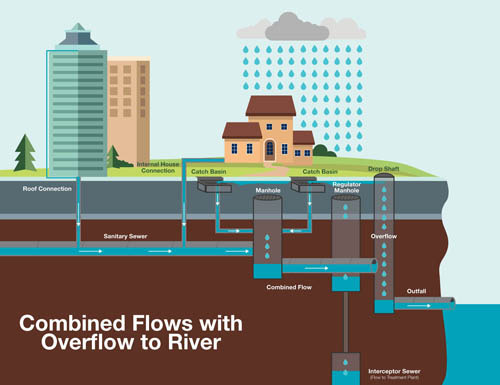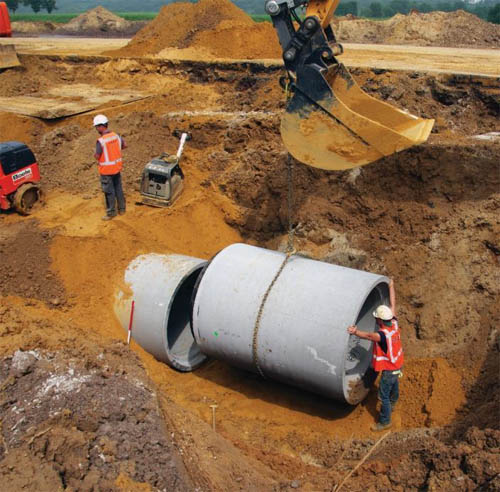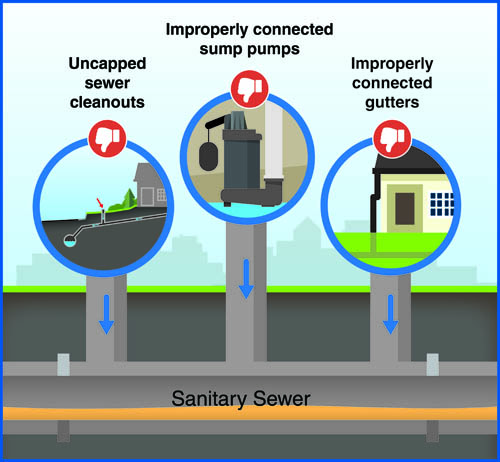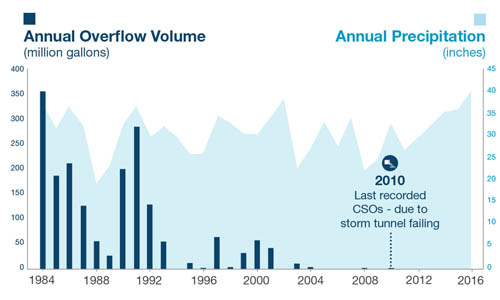The Metropolitan Council and City of Minneapolis have reached another milestone in joint efforts to protect public health and water quality. The Minnesota Pollution Control Agency recently agreed to end a longstanding permit that had regulated the release of combined stormwater and wastewater overflow into the Mississippi River.
 “A combined sewer overflow into the river hasn’t occurred since 2010, demonstrating that local and regional investments to separate the systems—and to reduce inflow and infiltration of groundwater and stormwater into the wastewater system—are reaping benefits,” said Jeannine Clancy, Assistant General Manager for the Council’s Environmental Services division (MCES).
“A combined sewer overflow into the river hasn’t occurred since 2010, demonstrating that local and regional investments to separate the systems—and to reduce inflow and infiltration of groundwater and stormwater into the wastewater system—are reaping benefits,” said Jeannine Clancy, Assistant General Manager for the Council’s Environmental Services division (MCES).
When the wastewater system was originally constructed, there weren’t separate systems in Minneapolis and Saint Paul to convey stormwater and wastewater—it all flowed into the same pipes.
During rainstorms, the pipes weren’t big enough to receive all that stormwater. Overflow pipes to the river were built because otherwise, the only place the water could go was back up the pipes where it came from—into buildings, homes and onto the streets. As recently as 1984, 350 million gallons of combined stormwater and wastewater (sewage) overflowed into the Mississippi in one year, mostly during major rainstorms or during snowmelt.
But thanks to a multi-faceted, collaborative strategy, the overflow has been eliminated. Key strategies leading to elimination of overflows include:
-
Minneapolis and Saint Paul Invested about $330 million in new infrastructure in to separate the stormwater and wastewater systems.
-
MCES built infrastructure in Minneapolis and St. Paul to address wastewater system capacity issues.
-
Deciding not to build storage capacity for excessive inflow and infiltration (I/I) of stormwater and groundwater into wastewater pipes.
-
Creating a regional program, in partnership with local communities, to reduce I/I.
-
Requiring communities served by the regional wastewater system to address I/I from private property sources in the current round of local comprehensive plan updates.
-
Renewing regional wastewater infrastructure with about $1 billion in Metropolitan Council Environmental Services (MCES) capital investments over the last decade.
Notably, Minneapolis and Saint Paul are the only major metropolitan cities in the country that are no longer subject to a permit related to combined sewer overflows. And this is the only region that made the decision to separate the two systems instead of building storage and treatment facilities for combined overflow.
Infrastructure has evolved over the decades
The initial construction of combined sewers began in the 1880s. Both stormwater and untreated wastewater were conveyed to the river by a single system. By 1922, construction started on the first separate storm sewers around the lakes in Minneapolis and in newly developing areas.
 In 1938, the Metropolitan Wastewater Treatment Plant opened in Saint Paul, where the combined stormwater and wastewater was treated.
In 1938, the Metropolitan Wastewater Treatment Plant opened in Saint Paul, where the combined stormwater and wastewater was treated.
In the 1960s, sewer separation started in Minneapolis and Saint Paul on a much larger scale in connection with infrastructure improvement projects, like street and highway construction. In 1984-85, the Metropolitan Waste Control Commission (predecessor to MCES) and the cities agreed to a new study and an initial Combined Sewer Overflow (CSO) permit. Upon consultation with the cities, a plan was adopted to separate the sewers.
In 1986, the MPCA, cities and the MWCC agreed on a CSO permit with a 10-year sewer separation program, followed by 5 years of an effectiveness evaluation. In total, the two communities spent an estimated $330 million in funds (some state and federal) to separate the sewer systems from the 1960s to the 1990s. At the same time, the MWCC invested $100 million dollars to build large interceptors (wastewater collection pipes) to address capacity issues in Minneapolis and Saint Paul and to separate the systems.
Separation program saved region billions of dollars
“The region has avoided spending billions of dollars by separating the sewers instead of building additional capacity for treatment and storage,” Clancy said. “Communities across the country are now under federal consent decrees to eliminate their combined sewer overflows, at a cost of billions of dollars.”
Minneapolis now works under what’s called an “integrated MS4 permit.” The permit provides a foundation for stormwater ordinance upgrades and requires an integrated infrastructure management program, explained Katrina Kessler, Director of Surface Water and Sewers for the City of Minneapolis. For example, stormwater and wastewater infrastructure upgrades are done in conjunction with other large construction projects, like the extensions of both the Green and Blue light rail lines.
Investing now to manage more frequent intense rainstorms
Despite sewer separation, some stormwater still gets into wastewater pipes. Sources include sump pumps or rain gutters that are improperly connected to the sanitary sewer system, and groundwater that seeps into pipes through cracks and broken joints in aging pipes. That’s why the Council’s ongoing program to reduce I/I, in partnership with communities, is critical.
T he Council and communities have invested hundreds of millions to repair cracked pipes, broken joints and deteriorated maintenance holes. But up to 80% of clear water entering the wastewater system comes from private infrastructure, so fixing sources of I/I on private property is just as important. For the first time, communities need to address I/I reduction from private property in their comprehensive plan updates, due to the Council by the end of 2018.
he Council and communities have invested hundreds of millions to repair cracked pipes, broken joints and deteriorated maintenance holes. But up to 80% of clear water entering the wastewater system comes from private infrastructure, so fixing sources of I/I on private property is just as important. For the first time, communities need to address I/I reduction from private property in their comprehensive plan updates, due to the Council by the end of 2018.
The increasing frequency of intense rainstorms is putting additional pressure on municipal stormwater systems. The Council and Minneapolis—where interceptors receive flow from 11 communities upstream—have entered into a joint study of interceptor system flow. The goals are to:
-
Identify areas with high inflow and infiltration
-
Identify areas with limited sewer capacity
-
Develop strategies to lower risks of sewer overflow
-
Evaluate alternatives
-
Prioritize future investments in the sanitary sewer
-
Inform decisions for future capital projects
Sewer separation, I/I reduction have avoided large capital expenditures
To provide enough sewer capacity for current and future generations, sewer pipes and treatment plants are designed for peak flows. The greater the volume of clear water entering the system, the bigger all those facilities need to be and the more they cost.
 Despite regional population growth and average annual precipitation gradually increasing, the annual wastewater flow to regional treatment plants in the last decade has declined. While water conservation plays a role, I/I reduction efforts have been essential.
Despite regional population growth and average annual precipitation gradually increasing, the annual wastewater flow to regional treatment plants in the last decade has declined. While water conservation plays a role, I/I reduction efforts have been essential.
“By separating our stormwater and wastewater systems, continuing to reduce I/I in the wastewater system, and through investments made by communities to manage stormwater, this region has protected public health and our water quality, while avoiding much larger costs,” Clancy said.
The average household in the Twin Cities region pays about 40% less for wastewater service than households in regions with similarly-sized wastewater systems.